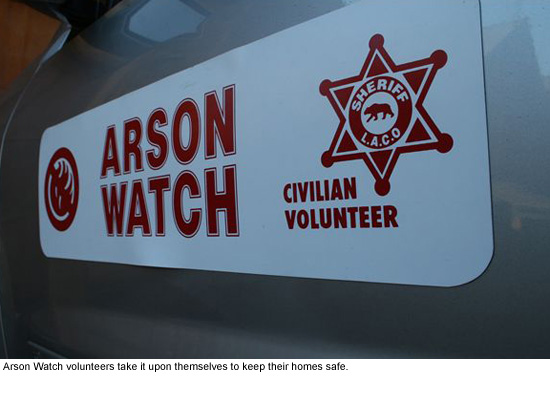The hills have eyes
June 30, 2011
They’ll be watching the fireworks, but not like the rest of us. For them, it’s personal, a call to duty.
On this Fourth of July, the volunteers of Arson Watch once again will be positioning themselves throughout 185 square miles of the Santa Monica Mountains, keeping an eye out for illegal fireworks and holiday revelers who could spark fires in the tinder-dry hills.
“We don’t want a great family holiday to turn into an out-of-control, raging nightmare,” says Sharon Donaldson, public information for the group, which works hand-in-hand with the Los Angeles County Sheriff’s Department.
Like others in the group, Donaldson says that she and her husband joined Arson Watch after a brush with flames themselves. In their case, the “Old Topanga Fire” of 1993 blazed dangerously close to their home while they were vacationing in Hawaii. They watched the whole thing unfold on CNN.
“It was the worst feeling in the world. It was horrifying,” she says. “You’re feeling totally helpless, watching your neighbors’ houses in flames.”
The group was founded in 1982 by the late actor Buddy Ebsen after the “Dayton Canyon Fire” torched his neighbors’ homes and gravely threatened his family and ranch. When he learned that the inferno was arson, he sprung into action. Along with his daughter Cathy, he aggressively recruited his neighbors to help local authorities prevent future fires, forming the original nucleus of Arson Watch.
Today, Arson Watch is staffed by 112 volunteers who log 2,500 to 4,000 hours per year. They assist the Sheriff’s Department at the Lost Hills/Malibu station by patrolling, talking to the public and serving as witnesses. They represent an early warning system in case of an actual fire, notifying fire officials who can try to contain it.
“We are the eyes and the ears of the Santa Monica Mountains when there is fire weather,” says Donaldson, who adds that their presence alone can serve as a deterrent.
While there’s no way to definitely gauge the deterrence effect of Arson Watch, its members note that there has been only one major fire started in the Topanga/Malibu area since the group was launched—the fatal blaze that raced through Donaldson’s neighborhood.
Independence Day, with so many people in party mode, poses some unique and tricky challenges for the volunteers.
For example, on one recent July 4th, an Arson Watch volunteer was alone in remote Tuna Canyon, walking on a fire road where the public is not permitted. There, winds can quickly whip a spark into a wall of flame. The volunteer was soon overwhelmed by a crowd of young people clambering up a bluff to throw an impromptu “rave,” says Donaldson.
She remembers hearing his concerned voice over their two-way radios. Hundreds of partiers were upon him, carrying fireworks and smoking. Refusing his pleas to leave, he enlisted help from the sheriffs, who broke up the dangerous celebration.
According to data from the National Fire Prevention Association, illegal fireworks caused an estimated 18,000 reported fires in 2009, including 1,300 structure fires, 400 vehicle fires and 16,300 “outdoor and other” fires. In all, they caused a reported $38 million in property damage and 30 reported injuries.
The risk is especially high in wildfire-prone regions, such as the Santa Monica and San Gabriel mountains. The California Department of Forestry and Fire Protection has already recorded 33 major wildfires in 2011. About two weeks ago, Governor Jerry Brown issued an executive order devoting more resources to fighting and preventing the fires.
This 4th, remember that all fireworks are illegal in L.A. City, unincorporated parts of L.A. County, and in other cities including Pasadena and Long Beach. A few cities such as Gardena and Alhambra permit “safe-and-sane” fireworks–but there are restrictions on who, where, and when they can be used.
The penalties for illegal fireworks can be severe. Small amounts are confiscated and may incur fines, says Sergeant Mark Bock of L.A. County Sheriff’s Malibu/Lost Hills Station. However, aerial fireworks and others like M-80s are considered explosives, and can bring felony charges. If the fireworks injure or kill anyone, perpetrators can be charged with serious felonies like mayhem, manslaughter, or even murder.
Donaldson recommends leaving fireworks to the pros, and suggests contacting law enforcement if you see people lighting them.
“It’s illegal, number one, and it’s not worth it,” she said. “There are amazing fireworks shows everywhere; you can go see these professional shows and not put lives at risk.”
She and her fellow Arson Watchers will be in the mountains this weekend to make sure people heed that advice.
Posted 6/30/11













 405 bridge work causes a stink
405 bridge work causes a stink
